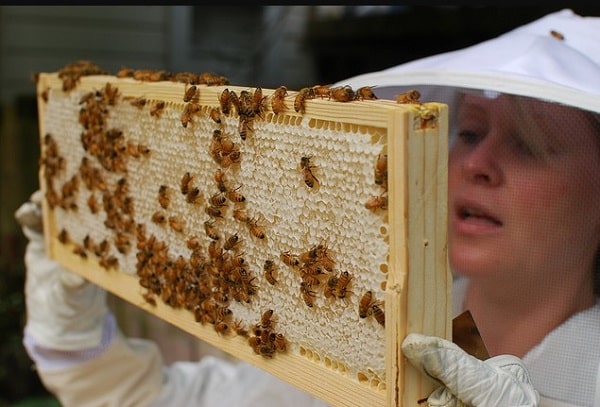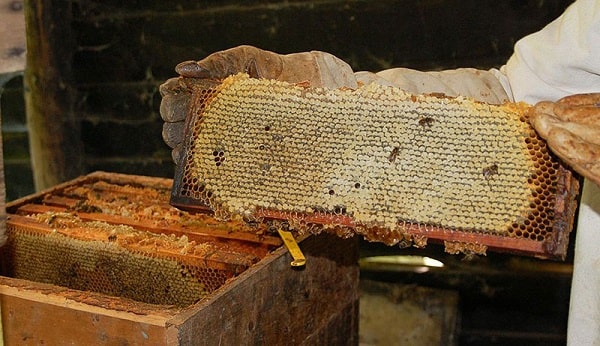Do you have any bees? If so, have you ever tried harvesting your own honey? Today, we’d want to share how we accomplished it in the hopes of assisting anyone who is thinking of beekeeping or looking for tips on how to gather their own honey. So, how to harvest honey at home?
Determine the best time to harvest honey
On a sunny day, the majority of bees forage between 9:00 AM and 4:00 PM. Harvest the honey during this time frame to ensure that there are fewer bees to deal with.
The season in which you harvest can also have a significant impact on the yield and quality of your honey. Because the bees stop producing honey to feed the queen in the late summer and early fall, more of the clusters are left empty. As a result, honey should be harvested early in the season.
If honey in open cells (not capped with wax) is cured, it can be removed. Turn the frame so that the cells face the ground to see if it is cured. Shake the picture frame gently. Honey that escapes from the cells is not healed and should not be harvested. This nonsense is not even true. It’s nectar that has not been fermented. The water content is too high to be classified as honey. Attempting to bottle the nectar yields runny syrup that will ferment and deteriorate.

Obtaining the Honeycomb
-
Put on your safety equipment
When harvesting honey, a full beekeeper’s gear is recommended. Make sure you have thick elbow-length gloves, a veiled hat, and bee-proof overalls at the very least. Wear a long-sleeved shirt and long pants as well. If you are serious about beekeeping, you should consider purchasing a professional beekeeping suit.
-
Smoke the bees away gently
Start the smoker and make your way to the back of the hive. Blow smoke around the hive’s entrance before carefully removing the top and blowing smoke into the aperture. The bees should travel down in the hive and away from the honeycombs near the top as a result of this procedure. Use the smallest quantity of smoke possible, because smoke can alter the flavor of honey.
-
Open the hive
Lift the inner cover off the top of the hive with a hive tool. Bees use a resin compound known as “propolis” to seal the margins of their hive. Because the seal is quite strong, you will need to use a specialized tool to remove the inner cover.
-
Remove the bees
There could still be a few bees surrounding the frame you intend to remove. A tiny gas or electric blower is one of the safest ways to get rid of these bees.
If you do not have a blower, a “bee brush” will suffice. Bee brushes, on the other hand, can be dangerous since they agitate bees. To be safe, if any falling bees become trapped in the honey before you can remove them, you must take the trapped bees out by hand.
-
Bring the honeycomb into a confined space
If you leave the hive outdoors, bees in the vicinity will begin to congregate by the scent of honey. They will “rob” or feast on the honey, making extraction more difficult and unsuccessful.
As soon as you extract the honeycomb from the hive, you should process it. The honey will still be in a relatively fluid form at that moment. Allowing it to sit may cause it to harden. If the honey begins to harden before it can be processed, place it in a warm, sunny position for a few minutes.

Read more:
Using an extractor to extract honey
-
Place the frame into an extractor
There are both electric and manual variants available. Regardless of the type, the frame or honeycomb frames must be installed directly into the machine’s housing. Make sure you have the model’s instructions or understand how it works.
-
Spin the frames
Hand-crank the machine or turn it on and let the motor do the work. The honey will be pressed into the drum walls when the extractor spins the frames. It will eventually leak down to the bottom from there.
-
Strain the honey through cheesecloth
Set several layers of cheesecloth over the mouth of a collection bucket and place that bucket beneath the extractor’s faucet. Allow the honey to strain through the cheesecloth by opening the spigot. This straining step will remove any honeycomb, wax, or other debris that fell off during the extraction process. Be patient as the extraction and straining procedure can take several hours.
Honey extraction without an extractor
Fill a big bucket halfway with honeycomb. If you have not already, remove it from the frame. Divide the honeycomb into as many pieces as needed to put it into the container. For this step, you can normally split the honeycomb apart by hand.
Make a mush of the honeycomb. Crush the honeycomb with a large masher until it becomes a thick mush. You should shred the comb so small that you can not pick up any bits by hand.
The honey will then be filtered. On top of your collection bin, place a strainer, nylon stretch bag, or numerous layers of cheesecloth. Pour the broken honeycomb into the strainer, allowing the honey to separate and run into the bucket below.

Packaging the honey
-
Clean and sterilize your containers
Wash the jars or bottles that you intend to use in hot, soapy water. Rinse thoroughly, then totally dry. You can use glass or plastic containers. Whatever the containers are, you should clean them carefully to avoid contaminating the honey.
-
Bottle the honey
Spoon the honey into your prepared containers or pour it into them using a funnel. Use tight-fitting lids to seal jars and bottles. After you first package your honey jars, keep an eye on them for a few days. If any debris remains in the honey after two or three days, it should rise to the surface of each container. Remove any debris, then seal the honey jars for long-term preservation.
-
Keep in a safe place and enjoy
People often store natural honey, organic honey at room temperature for many months if sealed. The amount of honey you collect will vary depending on the size of your honeycomb, the health of your bees, and the season in which you harvest them. In perfect conditions, however, one honeycomb can provide approximately 3-1/2 lbs (1.6 kg) of honey.
Is honey harvesting harmful to bees?
In a nutshell, it does not hurt the bees. If they discover you are stealing it from them, they will most likely become enraged. So, when harvesting honey, you must be careful of what you are doing. Always ensure that the bees have plenty to eat.
As previously said, they will have adequate time to reestablish their honey supply in the spring. Even if you take everything except a frame or two of honey, it should not hurt them because they have lots of food resources.
You do not want to cut them down as much in the summer since bees work themselves to death (literally) creating honey. Do not expect them to complete a season’s worth of work in half the time.
Finally, in the fall, you can harvest some of their honey, but always make sure they have enough to last the winter. They will die if they do not, and you will have to invest in new bees the next season.
Conclusion
Itis incredible to collect honey at home. Then you may make quality honey while also keeping track of the bees’ activity. However, as previously stated, you must collect at the proper time to ensure the bees’ source of life and the quality of the honey. Best wishes.
Related Posts:
